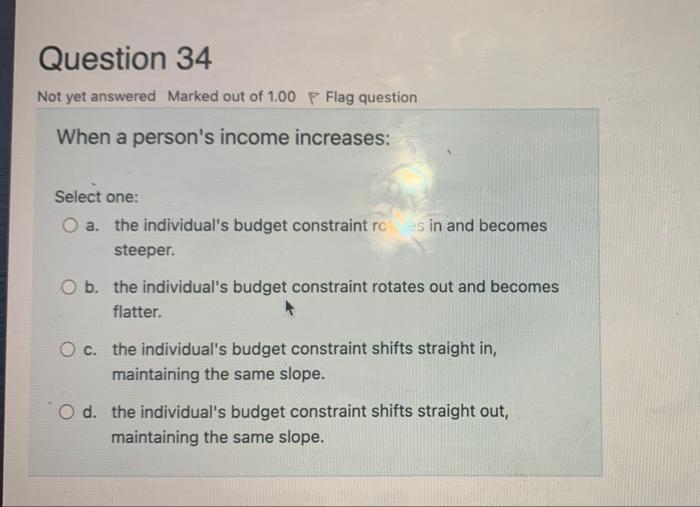Question 27 Not yet answered Marked out of 1.00 P Flag question The shape of the marginal utility curvis downward sloped. It is so because: Select one: O a. total utility curve is downward sloped. O b. marginal utility increases as we consume successive units of a good. O c. marginal utility from the next unit is less than that from the current unit. O d. total utility is equal to marginal utility when total utility is at its maximum. Question 31 Not yet answered Marked out of 1.00 P Flag question scoops of ice cream 1 2 3 4 total utility 10 utils 17 utils 21 utils 23 utils In the above example, what is the marginal utility of the 4th scoop of ice cream? Select one: O a. 25 utils. O b. 23 utils. O c. 21 utils. O d. 2 utils. Question 34 Not yet answered Marked out of 1.00 P Flag question When a person's income increases: Select one: O a. the individual's budget constraintro es in and becomes steeper. O b. the individual's budget constraint rotates out and becomes flatter. O c. the individual's budget constraint shifts straight in, maintaining the same slope. O d. the individual's budget constraint shifts straight out, maintaining the same slope. Question 37 Not yet answered Marked out of 1.00 P Flag question A perfectly elastic demand is one in which: Select one: a. the demand curve is perfectly horizontal. O b. measured elasticity is exactly 1. O c. the demand curve is perfectly vertical. Od the response to a change in price is immediate. Question 38 Not yet answered Marked out of 1.00 P Flag question A perfectly inelastic demand: Select one: O a. means people will respond to any change in price. O b. means demand will drop to zero if the price changes by any amount. O c. is demonstrated by a perfectly horizontal demand curve. od means people will not respond to any change in price. Question 39 Not yet answered Marked out of 1.00 P Flag question If the price of jelly goes up by 10 percent, we observe a decrease in the demand of peanut butter of 20 percent. The cross-price elasticity of these goods is: Select one: O a. -5. O b. -2. O c. 0.5. O d. 3











